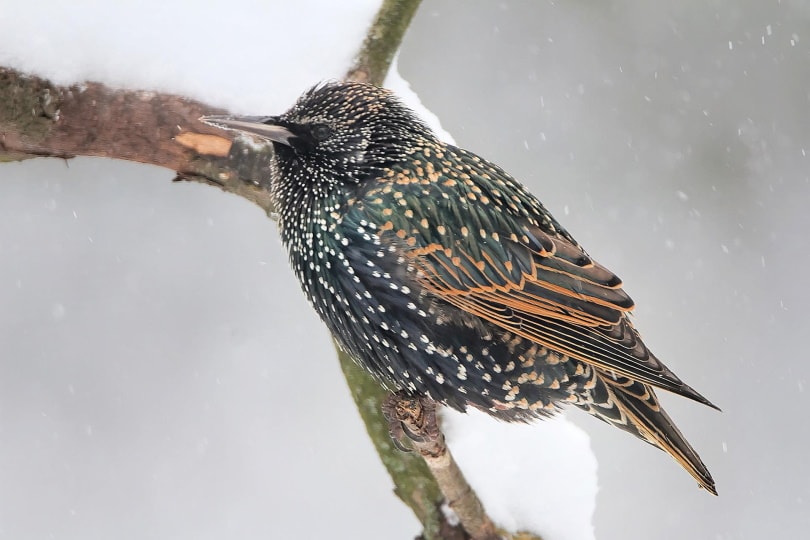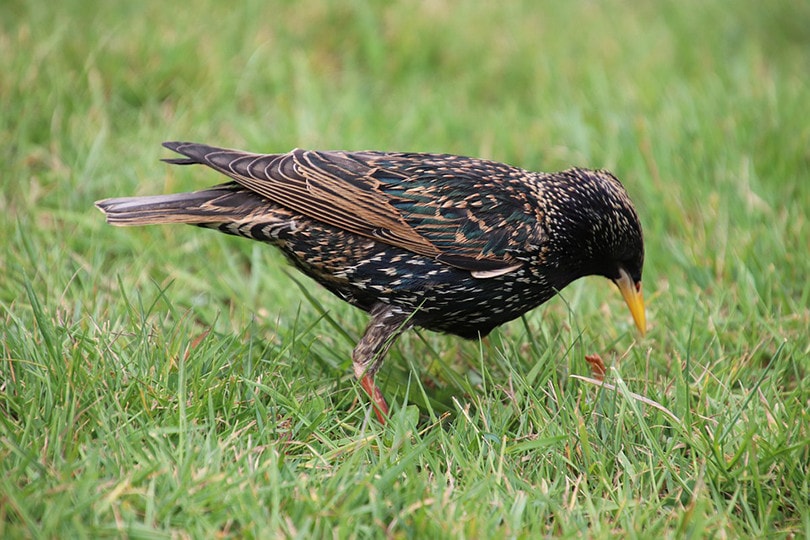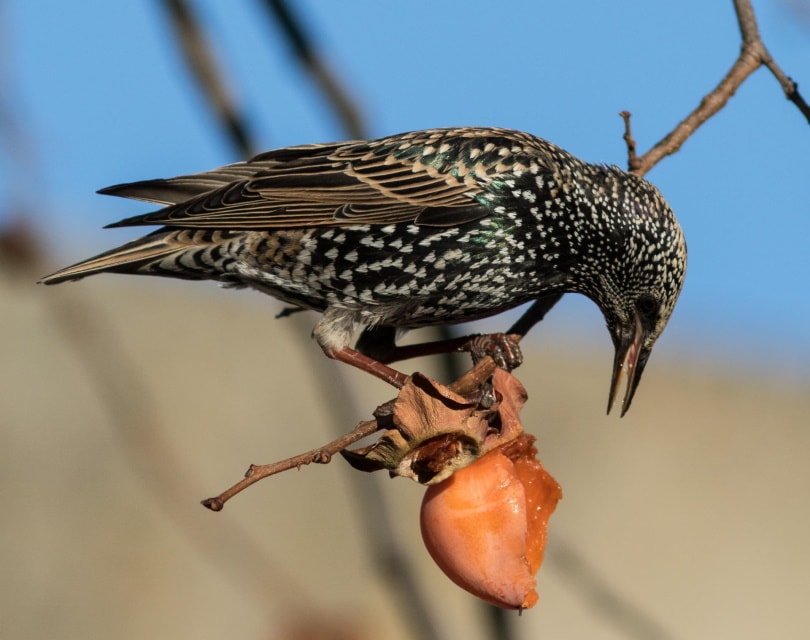European Starling: Field Guide, Pictures, Habitat & Info
Last Updated on

Although the European Starling is considered a pest in most locations, this bird is beloved for its adaptability and toughness. Though the species was only brought to North America in 1890, it can now be found across the continent.
No matter where you live in the United States, you will be able to see this boisterous bird. You’ll even be able to see it in parts of Canada. Because of how common this bird is, it’s one species you will want to learn how to identify.
The good news is that identifying these unique birds is pretty easy. Read on to learn how to identify a European Starling and attract more to your yard.

Quick Facts about the European Starling
| Habitat | Most locations like farm country, suburbs, and cities |
| Diet | Insects, berries, and seeds |
| Behavior | Highly sociable; mostly seen in large flocks; known for mimicry |
| Nesting | Male establishes territory and attracts mate through song; females nest in small cavities |
| Conservation | Least concern; negatively impacts some native species |
| Scientific name | Sturnus vulgaris |
| Lifespan: | 2–3 years |
European Starling General Description
European Starlings are considered the same size as a blackbird, but they have short tails and long, thin beaks. When in flight, their wings are pointed yet short, which makes them appear almost like a four-pointed star, after which the species is named.
European Starlings look black from a distance, but their color changes slightly throughout the season. In the summer, they will have a purplish-green iridescent color and yellow beaks up close. In the winter, they have brown plumage that is covered in white spots instead.

European Starling Range, Habitat, Behavior, Diet & Nesting
European Starlings can be seen all over. Whenever you see one, you will likely see a flock of other starlings and similar species. They also have pretty boisterous and sociable personalities, making them difficult to miss.
Range
Although European Starlings are native to Europe, they can be found nearly all throughout North America. They are found all throughout the continental United States and most of Canada. They can be found in rural countryside and farms, but they can also be found in towns, suburbs, and even cities.
Habitat
Because European Starlings are so adaptive, their habitat is practically everywhere. They prefer to feed on the ground, forging through fields, lawns, and sidewalks. They perch up high and roost on trees, wires, and buildings.
Behavior
European Starlings are incredibly sociable, boisterous birds. They love to travel in large groups, and they can often be seen amongst grackles and blackbirds. Often, they will race across fields to get to food, but they are almost always grouped with other birds.
Interestingly, European Starlings are known to mimic other birds and creatures. For this reason, European Starlings are considered to be intelligent species.

Diet
These birds are not picky eaters. They eat a diet of mostly insects, berries, and seeds, but their diet is varied. If insects are available, that is what they will prefer. They eat a lot of beetles, grasshoppers, caterpillars, flies, earthworms, snails, and spiders. When fall and winter roll around, they eat more fruits, seeds, and berries.
Nesting
The male will establish his territory and choose a nesting site. He will also begin attracting a mate through song. Whenever the female arrives, the male will perch next to the nest and begin singing while waving his wings. Males often mate with more than one female per season.
European Starling nests are normally in cavities, but they prefer to be in naturally hollow trees, such as a hole made from a woodpecker. They will sometimes nest in buildings, birdhouses, and other odd spots. Although males begin building the nest, females finish it and sometimes get rid of the male materials. The nest is made from twigs, leaves, grasses, trash, and other items that the birds find.
How to Find the European Starling: Birdwatching Tips
Once you know what to look for when bird watching for European Starlings, the task gets pretty easy. Because these birds are so common and boisterous, they are hard to miss. Here are some tips for spotting European Starlings:

What to Listen For
Listening for a European Starling can be confusing. Because these birds mimic other creatures, they can make many sounds. They are known to make chattering, whistling, wobbling, trilling, and rattling sounds to sound like other birds.
What to Look For
If you want to find European Starlings, the best thing to do is look at the ground. You will often see these birds zigzagging across the ground while stabbing their bills into the soil beneath. You will see a big group of birds doing the same.
When to Look
In most locations, you can look for European Starlings year around. They are generally nonmigratory unless you live far north where the winters get incredibly cold. In most of the United States, these birds are not migratory and stay put all year.
Attracting European Starlings to Your Backyard: Tips & Tricks
The best way to attract European Starlings to your backyard is to provide an abundance of food and water. Set up a birdbath for water, but put suet, seeds, and berries directly on the ground. You might also want to consider hanging up bird feeders that allow the seeds to fall to the ground.
Consider clearing away space for their nests as well. European Starlings are more likely to stay in areas where they can nest year-round since males tend to stay in one area for their entire lives.

European Starling Conservation: Is this Bird Threatened?
No. European Starlings are not threatened. On the contrary, they have some damaging effects on native species, such as certain bluebirds.

Final Thoughts
If you are looking for a European Starling, you don’t have to look too hard. Look for medium-sized black birds with unique patterns that fly in groups and forage on the ground. No matter where you live in the United States, you probably won’t have to go too far to look for one of these birds.
- You might also like: Common Loon: Field Guide, Pictures, Habitat & Info
Featured Image Credit: Naturelady, Pixabay
Table of Contents
- Quick Facts about the European Starling
- European Starling General Description
- European Starling Range, Habitat, Behavior, Diet & Nesting
- How to Find the European Starling: Birdwatching Tips
- Attracting European Starlings to Your Backyard: Tips & Tricks
- European Starling Conservation: Is this Bird Threatened?
- Final Thoughts
About the Author Robert Sparks
Robert’s obsession with all things optical started early in life, when his optician father would bring home prototypes for Robert to play with. Nowadays, Robert is dedicated to helping others find the right optics for their needs. His hobbies include astronomy, astrophysics, and model building. Originally from Newark, NJ, he resides in Santa Fe, New Mexico, where the nighttime skies are filled with glittering stars.
Related Articles:
How to Clean a Refractor Telescope: Step-by-Step Guide
How to Clean a Telescope Eyepiece: Step-by-Step Guide
How to Clean a Rifle Scope: 8 Expert Tips
Monocular vs Telescope: Differences Explained (With Pictures)
What Is a Monocular Used For? 8 Common Functions
How to Clean a Telescope Mirror: 8 Expert Tips
Brightfield vs Phase Contrast Microscopy: The Differences Explained
SkyCamHD Drone Review: Pros, Cons, FAQ, & Verdict
